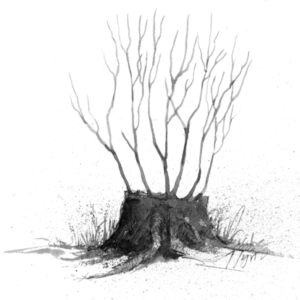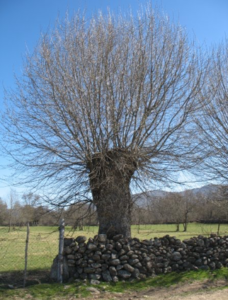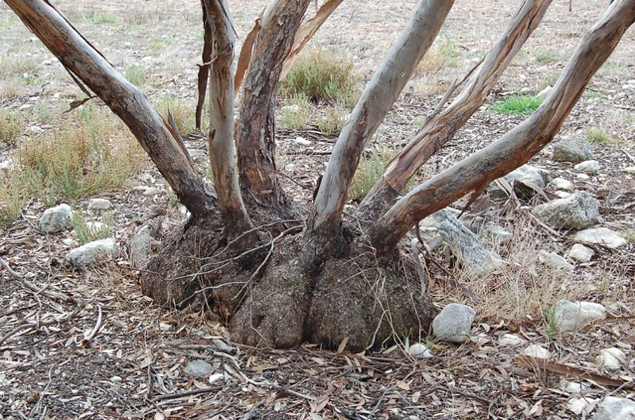Module 10: Promoting Natural Regeneration of Commercial Species
Topic 10.3: Vegetative Expansion and Resprouting of Damaged Plants
Most species have a considerable capacity to recover vegetatively after being broken or otherwise mechanically damaged. Evidence from England indicates that silviculturalists have been taking advantage of this capacity at least since the Bronze Age (1000 years before present) by coppicing trees for production of building poles and other small-dimension materials. Coppicing refers to cutting tree stems near the ground and then managing the sprouts that emerge from the stump (also referred to as a “stool”; Figure 10.3.1 left). When the stems of trees are lopped off up to several meters above the ground and the tree resprouts, the process is referred to as “pollarding” (Figure 10.3.1 right); trees are often pollarded in agroforestry systems in which seasonal reductions in shade are desired. For example, where browsing animals are likely to damage new sprouts, or there is some other reason to avoid production of dense stands near the ground (e.g., in managing shade over coffee), trees can be pollarded by cutting them off 2-4 m from the ground. Species characteristic of ecosystems in which all plants are top-killed by intense fires that occur at multi-decadal intervals often produce “lignotubers” from which they sprout abundantly (Figure 10.3.1 bottom).



Figure 10.3.1 A sprouted stump or stool (top left), a pollarded tree (top right), and a sprouted lignotuber (below).
Coppicing is commonly used in managing biomass plantations of some Acacia and Eucalyptus species, but has a role to play in natural forest management as well, especially in fire prone ecosytems. In the savanna woodlands of Africa, for example, many species are well represented by seedling and sapling-size individuals that are actually sprouts from stools that might be many decades old. Coppicing in these species occurs after fires or harvesting activities kill the plant down to the ground. Coppicing in many other forests is less obvious but no less important. Often a little excavation around the base of what might look like a recent seedling may reveal a much older root stock.` Some species in fire-maintained ecosytems develop a large underground stem referred to as a “lignotuber”—some lignotubers can be as large as one cubic meter, and many centuries old.
Resprouting of tree trunks broken by wind or damaged during logging is also very common but the long-term fates of these trees is less certain. Exposed wood at breakage points is susceptible to colonization by various pathogens and wood-rotting fungi, and compartmentalization of decay is often slow and ineffective in the already greatly stressed damaged trees. Consequently, a few years or decades after severe damage, many tree stems are hollow, even though the trees are still alive. Examination of the proportion of trees with forked stems or especially low branches can serve as a rough estimate of the frequency of breakage and resprouting. In many forests, 25% or more of the canopy trees have obviously suffered severe trauma in the past, with the incidence being even higher among understory species.
Perenniating organs and vegetative expansion
In addition to the lignotubers mentioned above, many plants have other organs that aid in vegetative expansion or recovery. Perenniating organs in plants with common examples. Rhizomes, stolons, bulbs, and corms). Even fallen stems can serve as a means for vegetative propagation; expansion by the rooting of fallen stems (=”layering”) is particularly common in lianas but not unknown in trees.
The capacity to spread vegetatively allows some plants to proliferate when conditions are not favorable for seedling establishment due to dry soils, deep shade, or voracious seed predators. Many graminoids and other monocots (e.g., many heliconias, cyclanths, and understory palms), for example, can develop into dense swards due to production of rhizomes or stolons. Similarly, a great capacity for vegetative recovery after fire or grazing is also characteristic of many graminoids.
